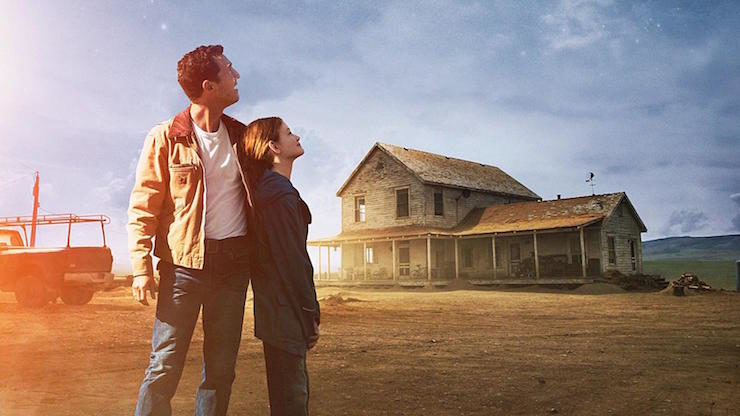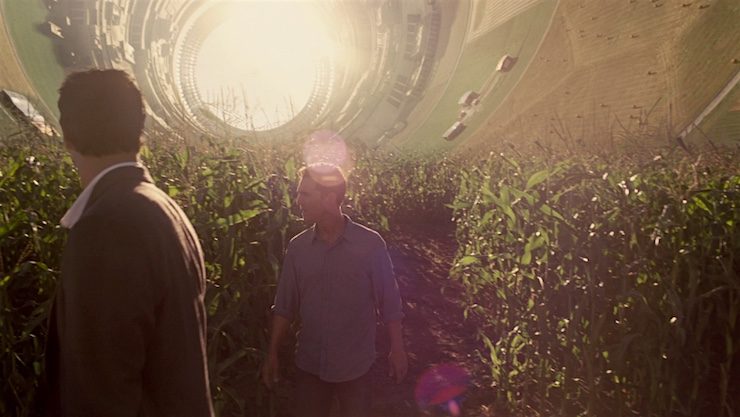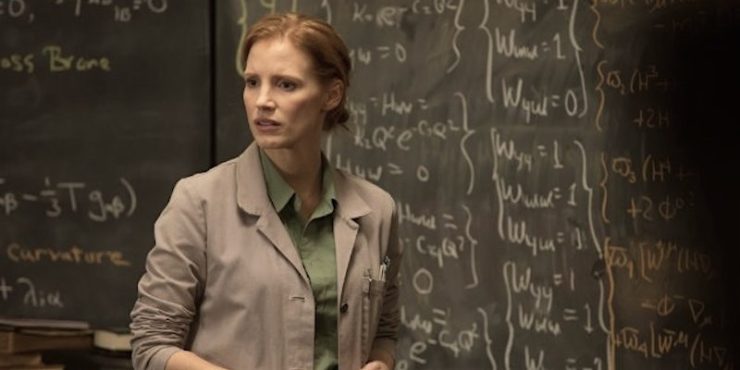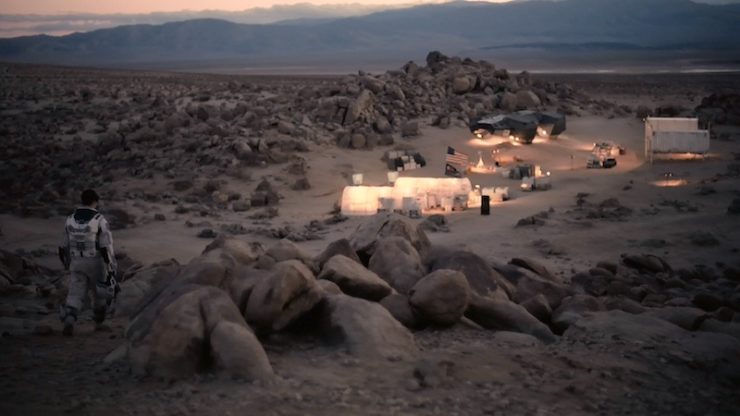If there’s one thing that sets Contact apart from its fellow big idea tent-pole movies, it’s pragmatism. As discussed in a previous essay, Contact is a grounded, smart look at one of the biggest events in human history. It takes its time to do this from multiple angles and goes to great pains to contextualise, if not excuse, each one of those viewpoints.
By contrast, Interstellar is far more seat-of-the-pants in style, throwing huge concepts at the screen with the chilly abandon its director, Christopher Nolan, is known for. That impulsive approach is the cause of a lot of the movie’s problems but it also defines everything from Coop’s emotional trajectory to the ultimate resolution of the movie itself.
Matthew McConaughey’s Coop is, superficially, a collection of ticked boxes. A father and grieving widower, he’s a test pilot who washed out (following an accident he’s convinced was not his fault) and now spends his time farming corn. Corn, incidentally, is the last available crop on the planet. Humanity doesn’t look up anymore. There are no dreams of moving off-world, only hopes of surviving on this one as everything dies around us.
So, parent, widower, pilot, farmer, astronaut. Coop is the centre of a complex Venn diagram of masculine ideals and he’s pretty terrible at all of them. He’s rarely at ease, hates farming, misses the days when NASA was the pinnacle of space exploration and is just marking time until his crops die or he does. When the plot hands him an opportunity to be more than a parent and a farmer, he jumps at it with both hands outstretched. The pitch sequence, where Professor John Brand (played by Michael Caine) explains the plan is played out for the benefit of the audience more than anything else; Coop’s signed up the moment he spots that Indian Drone coming in for a landing.

Taking that headlong leap into the unknown would be a victory in a simpler movie. Here it’s both a link in a chain of events a century wide and a surprisingly savage takedown of one of the most attractive elements of classic SF: the astronaut as infallible hero.
To be clear, Coop, Brand, Romilly, Doyle, and even poor Doctor Mann are unquestionably heroic. There is no way signing on for a probable one-way trip through a wormhole to an uncertain future could be anything other than that. However, Coop, both Brands (John and Amelia), and Mann—the characters we spend the bulk of the movie with—are hideously flawed.
Coop’s colossal failure as a parent and caregiver we’ve already touched on, but there’s also the fact that he can’t commit fully to either the mission or his family. His attempts to speed up their first expedition are entirely motivated by his desire to be away from his children for as short a time as possible and when those attempts fail, his grief is as much about having the choice taken from him as the time he’s lost with his children. He’s unsure, a dog with two bones, until what he thinks will be his final sacrifice. That moment, with Coop behind the stick on what he’s expecting to be his final flight, is remarkable because of how serene he is. McConaughey’s accent, his mannerisms, even his good-natured fatalistic banter with TARS all evoke the even-voiced men who rode ICBMs into low Earth orbit during the Cold War. Stripped of his family, his obligations, his past and his future, Coop is finally at peace. He’s a link in a chain, a rocket stage whose job is solely to push the actual astronaut, the actual heroine, all the way to her destination.

That much he can do. In fact, the humility inherent in this action is what really separates Coop from Doctor Mann (Matt Damon). In spite of what the character claims in his big speeches, he’s actually more concerned with huMannity than humanity. The fact that Doctor Mann dies through arrogance and in mid-monologue shows how out of touch he really is. The fact that Coop is prepared to die to give Brand a shot at reaching the last world and reuniting with her lover shows how at peace he finally is.
Of course that doesn’t last. The impulsiveness at the heart of both Interstellar and its lead protagonist comes together in one of the film’s most controversial sequences. The tesseract, where Coop closes the circle and becomes Murph’s “ghost,” is a beautiful visual but one of the movie’s major stumbling points for many viewers. It excuses, if not redeems, every single one of Coop’s actions and boils the fate of humanity down to nothing more than a brilliant, angry young woman finally realizing that her father never quite left her behind.
It shouldn’t work. For many viewers, it doesn’t, and neither does the earlier scene where Brand (Anne Hathaway) discusses the possibility that love is what we can consciously perceive of a much larger, multi-dimensional force. The fact that this theory comes from Brand is one of the few genuine missteps in Interstellar, given how fiercely pragmatic she is throughout the rest of the movie. But, when interpreted from a slightly different angle, it becomes less about Brand being uncharacteristically emotional and more about her showing Coop the path he needs to take. Amelia Brand is a brilliant scientist and astronaut who is comfortable with the discomfort of not knowing if her lover is alive or dead. Coop, as discussed, isn’t comfortable at all.
Brand’s complex, not-always-successful balancing of science and hope also speaks to the film’s larger narrative. It’s significant that Brand, not Coop, is the last person we see. It’s even more significant that she’s reached a habitable world, has set up camp, and has finally gotten her answer as to whether Edmunds is alive or not. She’s reached escape velocity, leaving everything behind, and is now faced with a clean slate of a world. No more seat-of-the-pants flying, no more impulsive choices. Even the imminent (relatively) arrival of Coop doesn’t change that. The world’s saved, there’s work to do, and they’re both ready for it.
That impulsiveness, embodied most fully in Brand’s father’s monstrous and altruistic lie about the gravity equations, is only escaped by two characters in the movie. The first is Amelia Brand, the second is Murph.
During the lion’s share of Murph’s screen time she’s played by Jessica Chastain, and it’s hard to imagine any other performer landing the character so perfectly. Murph is brilliant, angry, damaged, and absolutely refuses to let any of that get in her way. Murph is part of a generation that are constantly told how vital they are, but have had the deck stacked relentlessly against them. Her brother (Casey Affleck, in yet another chronically under-appreciated turn) makes his peace with that. She refuses to.
Coops’ abandonment of his family is the sand in Murph’s shoe, the irritant she spends a lifetime trying to remove and erase. It drives her to be better than her father even as it drives her towards helping him come home, or being ready for his return. Like the stages of a rocket, her grief moves through the traditional steps as she accepts his loss, discovers Professor Brand’s lie and, finally, learns the truth.
The thing that sets her apart is that Murph doesn’t give up. She cycles back around, again, to both her past and the ghost in her room. She uses the things she’s been taught as an adult to understand what frightened her as a child, and in doing so she makes her peace not only with her past but with her father. And in doing that, she saves the world.
That really can’t be emphasized enough. In a film that spends most of its running time focused on the epitome of the male hero, in the end, he’s just a step in a larger story. Murph is the one who solves the problem. Murph is the one who balances her dad’s impulsiveness with methodical, relentless scientific method and patience. Murph is the one who sees what’s there, not what she’s conditioned to see. The little girl whose brother teases her about her name grows up to be the woman who saves her species. No wonder they name the station after her.
That payoff puts all of Interstellar’s failings in perspective for me. It’s a film about a last ditch mission to save the Earth that’s founded on a lie and wrapped up in temporal causality that the people involved don’t care to think too much about, because they either don’t have the time or are too busy concealing their own failures. It shouldn’t work. Like the Endurance mission itself, it’s an enthusiastic confection, a best-case collection of ideas that sometimes barely fit together.
Scrappy, untidy and uneven, Interstellar isn’t the last astronaut movie but is about the last astronaut, the ghost of the classic science fiction adventurer who turns out not to be the true hero in this story at all. In the end, this is really a movie about who comes after him: the future, not the past.
Alasdair Stuart is a freelancer writer, RPG writer and podcaster. He owns Escape Artists, who publish the short fiction podcasts Escape Pod, Pseudopod, Podcastle, Cast of Wonders, and the magazine Mothership Zeta. He blogs enthusiastically about pop culture, cooking and exercise at Alasdairstuart.com, and tweets @AlasdairStuart.












